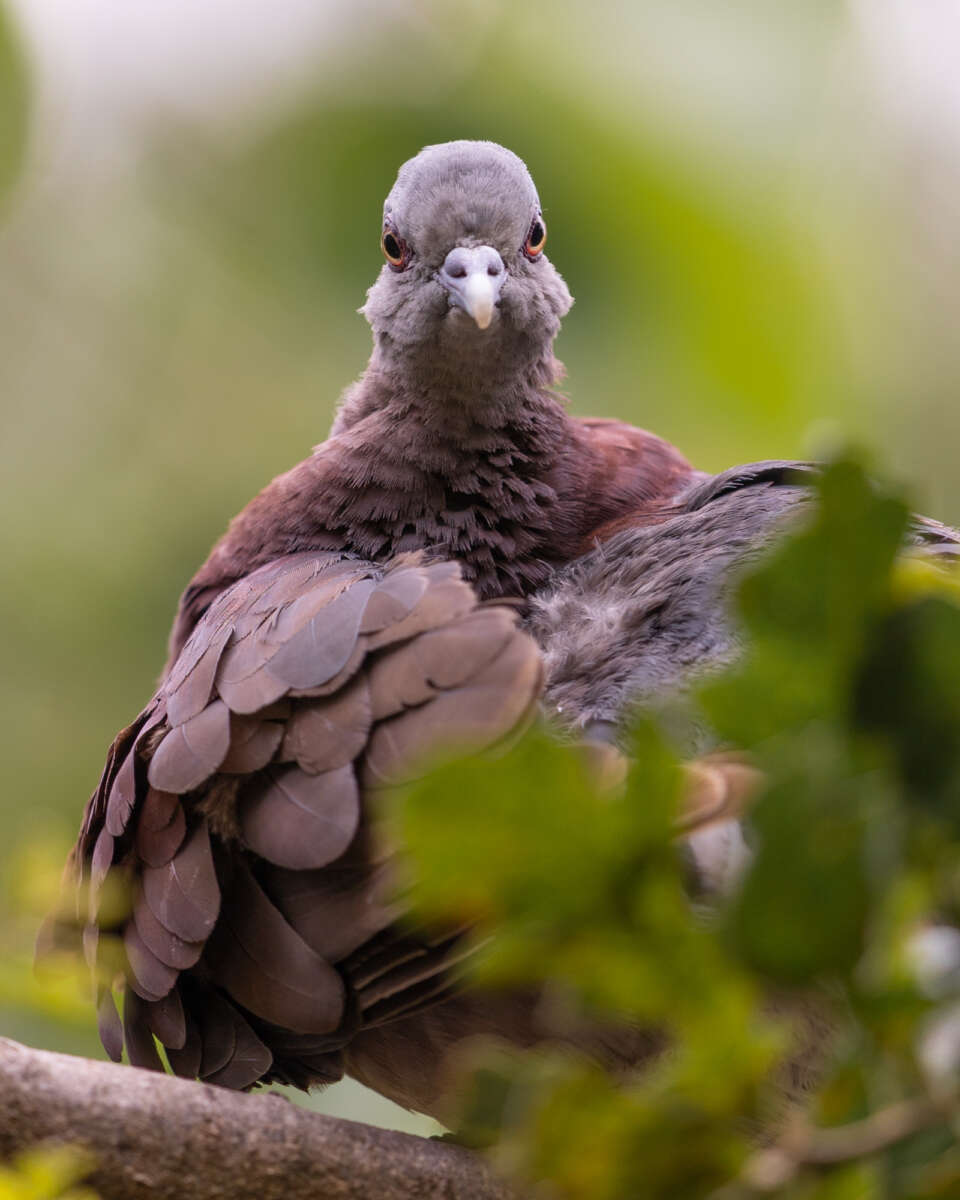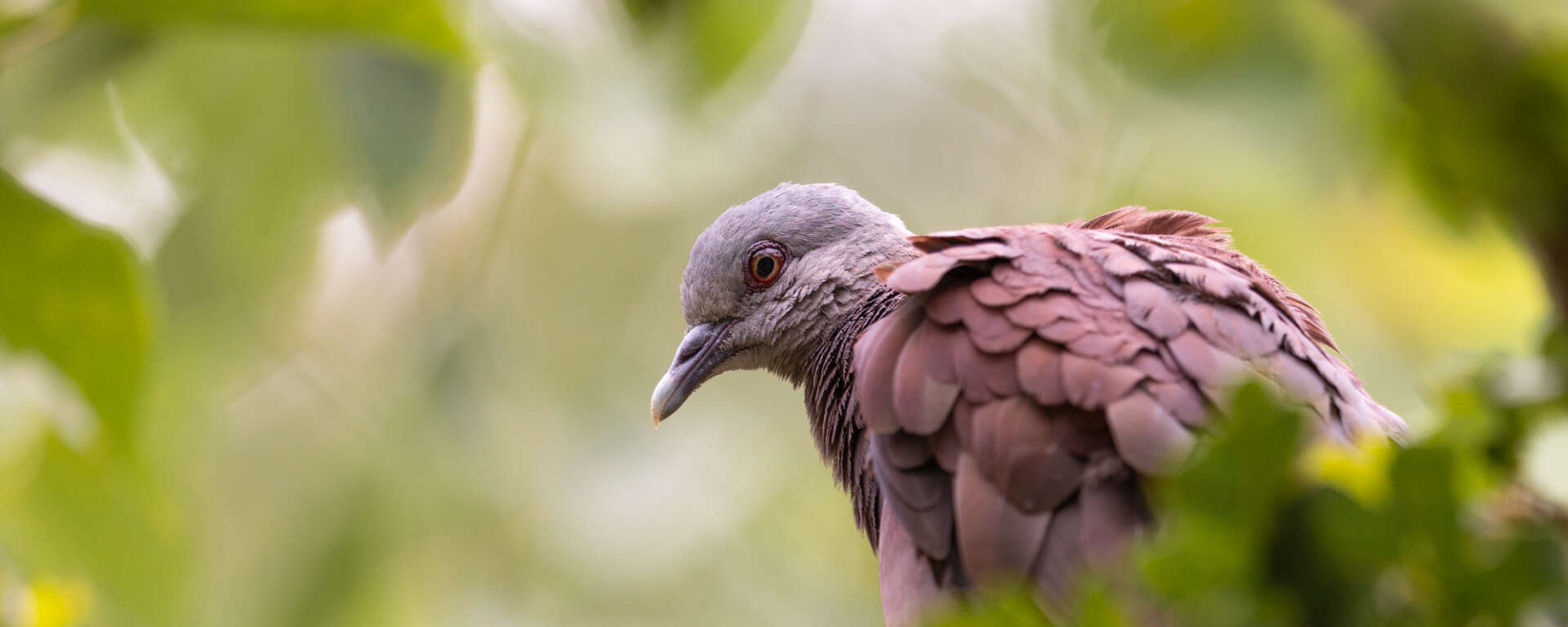Description
The Madagascar turtle dove, also aptly called the painted dove, is a beautiful blend of browns, purplish-reds, and blueish-grays. It has a brown eye with a red circle around it, and a short beak ideal for eating seeds.
Cover photo: Adult Madagascar turtle dove by Mark Pressler
Classification
- Overview
- The Madagascar turtle dove is a bird in the columbid, or pigeon and dove family. The only other extant species in the same genus Nesoenas as the Madagascar turtle dove is the pink pigeon, a species only found on the island of Mauritius in the Indian ocean. The pink pigeon nearly went extinct, with only 10 individuals remaining in 1991, but has since rebounded to somewhere between 250 – 1000 individuals due to conservation efforts.
- Class
- Aves
- Order
- Columbiformes
- Family
- Columbidae
- Genus
- Nesoenas
- Species
- N. picturatus
Key Facts
- Conservation Status
- Least Concern
- Lifespan
- Insufficient data. Many columbids have a ~10 – 20 year lifespan
- Height
- 11 in (28 cm)
- Weight
- 5.2 – 6.6 oz (146 – 188 g)
- Wingspan
- 14.6 – 16.9 in (37 – 43 cm)
The IUCN Red List describes the Madagascar turtle dove as a species of Least Concern, meaning conservationists across the world are not currently worried about the continuation of this species. The population size on Madagascar is unknown, but this dove is described as being very common throughout the island.
Social Life
Little is known of the social life of the Madagascar turtle dove. Pigeons and doves have a wide spectrum of sociality, ranging from being largely asocial to regularly flocking in large numbers. Most pigeons and doves form monogamous pair-bonds, at least for the extent of a single breeding season.
Habitat and Range
This dove prefers woodland habitat, but is also found in degraded forests, croplands, and near human habitation.
Madagascar turtle doves are found across the island of Madagascar. There are also small populations on smaller islands in the Indian Ocean, including many islands in the Seychelles archipelago and Comoros. They are a non-migratory species.
Diet
The diet of the Madagascar turtle dove is largely seeds, but they will also eat some fallen fruit and invertebrates. They mostly forage on the ground in woodland habitat.
Predators
Little is known about the most common predators of the Madagascar turtle dove, but it is likely that all of the medium-sized carnivores on Madagascar occasionally prey upon this dove. This includes the fossa, falanoucs, civets, mongooses, and the non-native forest cat.
Reproduction
Sexual Maturity: unknown, usually ~1 year in pigeons & doves
Nesting Season: July – February in Madagascar, October – November in Comoros
Incubation: unknown, ~15 – 20 days in similarly sized pigeons & doves
Clutch Size: 2 eggs
- Information
-
Description
The Madagascar turtle dove, also aptly called the painted dove, is a beautiful blend of browns, purplish-reds, and blueish-grays. It has a brown eye with a red circle around it, and a short beak ideal for eating seeds.
Cover photo: Adult Madagascar turtle dove by Mark Pressler
Classification
- Overview
- The Madagascar turtle dove is a bird in the columbid, or pigeon and dove family. The only other extant species in the same genus Nesoenas as the Madagascar turtle dove is the pink pigeon, a species only found on the island of Mauritius in the Indian ocean. The pink pigeon nearly went extinct, with only 10 individuals remaining in 1991, but has since rebounded to somewhere between 250 – 1000 individuals due to conservation efforts.
- Class
- Aves
- Order
- Columbiformes
- Family
- Columbidae
- Genus
- Nesoenas
- Species
- N. picturatus
Key Facts
- Conservation Status
- Least Concern
- Lifespan
- Insufficient data. Many columbids have a ~10 – 20 year lifespan
- Height
- 11 in (28 cm)
- Weight
- 5.2 – 6.6 oz (146 – 188 g)
- Wingspan
- 14.6 – 16.9 in (37 – 43 cm)
- Conservation
The IUCN Red List describes the Madagascar turtle dove as a species of Least Concern, meaning conservationists across the world are not currently worried about the continuation of this species. The population size on Madagascar is unknown, but this dove is described as being very common throughout the island.
- Lifestyle
Social Life
Little is known of the social life of the Madagascar turtle dove. Pigeons and doves have a wide spectrum of sociality, ranging from being largely asocial to regularly flocking in large numbers. Most pigeons and doves form monogamous pair-bonds, at least for the extent of a single breeding season.Habitat and Range
This dove prefers woodland habitat, but is also found in degraded forests, croplands, and near human habitation.Madagascar turtle doves are found across the island of Madagascar. There are also small populations on smaller islands in the Indian Ocean, including many islands in the Seychelles archipelago and Comoros. They are a non-migratory species.
Diet
The diet of the Madagascar turtle dove is largely seeds, but they will also eat some fallen fruit and invertebrates. They mostly forage on the ground in woodland habitat.Predators
Little is known about the most common predators of the Madagascar turtle dove, but it is likely that all of the medium-sized carnivores on Madagascar occasionally prey upon this dove. This includes the fossa, falanoucs, civets, mongooses, and the non-native forest cat.Reproduction
Sexual Maturity: unknown, usually ~1 year in pigeons & doves
Nesting Season: July – February in Madagascar, October – November in Comoros
Incubation: unknown, ~15 – 20 days in similarly sized pigeons & doves
Clutch Size: 2 eggs

Adult Madagascar turtle dove preening by Mark Pressler

